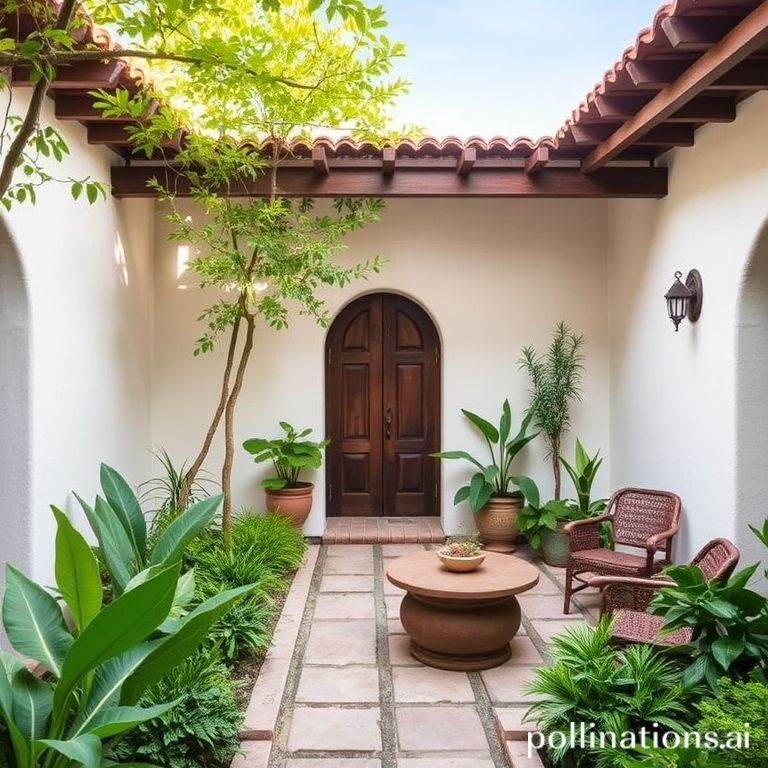The soul of a Mexican home often resides not within its walls, but in the tranquil space that lies at its heart: the courtyard. More than just an architectural feature, the courtyard, often adorned with a soothing fountain, is a sanctuary, a gathering place, and a testament to Mexico’s rich cultural heritage. These intimate outdoor spaces offer respite from the sun, a connection with nature, and a sense of peaceful seclusion. They are where families connect, stories are shared, and the rhythm of daily life unfolds.
From humble adobe dwellings to grand haciendas, the courtyard’s design adapts to different styles and regional influences, but its core purpose remains constant: to create a private oasis that enhances the living experience. A courtyard offers a blend of indoor and outdoor living, seamlessly integrating the home with the natural world.
The History of Mexican Courtyards
The concept of the courtyard isn’t unique to Mexico, but its adaptation and integration into Mexican architecture are distinctive. Courtyards have existed since ancient times, serving as vital components of homes in various cultures, including those of ancient Greece and Rome. The Spanish brought the courtyard design to Mexico during the colonial era. These designs then beautifully merged with existing indigenous traditions, resulting in the unique and charming courtyards we see today.
Originally, courtyards served practical purposes, providing ventilation, light, and a secure space for domestic activities. Over time, they evolved into decorative and social spaces, reflecting the homeowner’s taste and cultural identity. Colonial courtyards often featured elaborate fountains, intricate tile work, and lush gardens, showcasing the wealth and status of the family.
Elements of a Traditional Mexican Courtyard
While every courtyard is unique, certain elements are commonly found in traditional Mexican designs:
Fountains: The Sound of Serenity
- A fountain is often the centerpiece, its gentle splashing creating a soothing ambiance.
- Fountains can range from simple stone basins to elaborate multi-tiered structures adorned with colorful tiles.
Plants and Gardens: Bringing Nature In
- Lush greenery is essential, with potted plants, climbing vines, and small trees providing shade and color.
- Popular choices include bougainvillea, jasmine, citrus trees, and various succulents.
Colorful Tiles: A Visual Feast
- Hand-painted tiles, known as “azulejos,” are used extensively to decorate walls, floors, and fountains.
- These tiles often feature intricate patterns and vibrant colors, adding a touch of Mexican artistry.
Seating Areas: For Relaxation and Socializing
- Comfortable benches, chairs, and hammocks invite relaxation and conversation.
- Courtyards are often used for family meals, gatherings with friends, and quiet moments of reflection.
Lighting: Creating Ambiance
- Soft, warm lighting is essential for creating a welcoming atmosphere in the evening.
- Lanterns, candles, and string lights are commonly used to illuminate the space.
The Modern Mexican Courtyard
While traditional elements remain popular, modern Mexican courtyards often incorporate contemporary design features. Clean lines, minimalist furniture, and sustainable materials are increasingly common. However, the core principles of creating a peaceful and private outdoor space remain the same.
Modern courtyards may also feature updated amenities such as outdoor kitchens, fireplaces, and swimming pools, further enhancing their functionality and appeal.
Why Courtyards are Essential to Mexican Homes
Courtyards are more than just aesthetically pleasing; they offer numerous practical and emotional benefits:
- Temperature Regulation: Courtyards help to regulate the temperature inside the home, providing natural cooling in hot climates.
- Natural Light and Ventilation: They allow natural light and fresh air to circulate throughout the house, reducing the need for artificial lighting and air conditioning.
- Privacy and Security: Courtyards offer a private and secure outdoor space, protected from the outside world.
- Connection with Nature: They provide a connection with nature, promoting relaxation and well-being.
- Social Hub: Courtyards serve as a gathering place for families and friends, fostering social interaction and creating lasting memories.
Conclusion
Mexican courtyards and fountains are a testament to the country’s rich cultural heritage and its deep appreciation for the beauty of nature. They offer a tranquil retreat from the hustle and bustle of daily life, providing a space for relaxation, connection, and reflection. Whether traditional or modern, the courtyard remains an essential element of the Mexican home, a peaceful heart that nourishes the soul.
If you found this glimpse into Mexican architecture inspiring, share this article with friends and family, and be sure to explore our other articles about the vibrant culture and lifestyle of Mexico!
IMAGE: A sun-drenched Mexican courtyard. In the center, a stone fountain trickles water into a tiled basin. Lush bougainvillea vines climb the walls, their vibrant pink blossoms contrasting with the white-washed adobe. Clay pots overflow with greenery. Wrought-iron chairs sit invitingly around a small table. The overall mood is peaceful, warm, and inviting, capturing the essence of a tranquil Mexican home. The lighting is bright and natural, with dappled shadows creating depth and texture. Style: Travel photography, capturing authentic Mexican charm.


